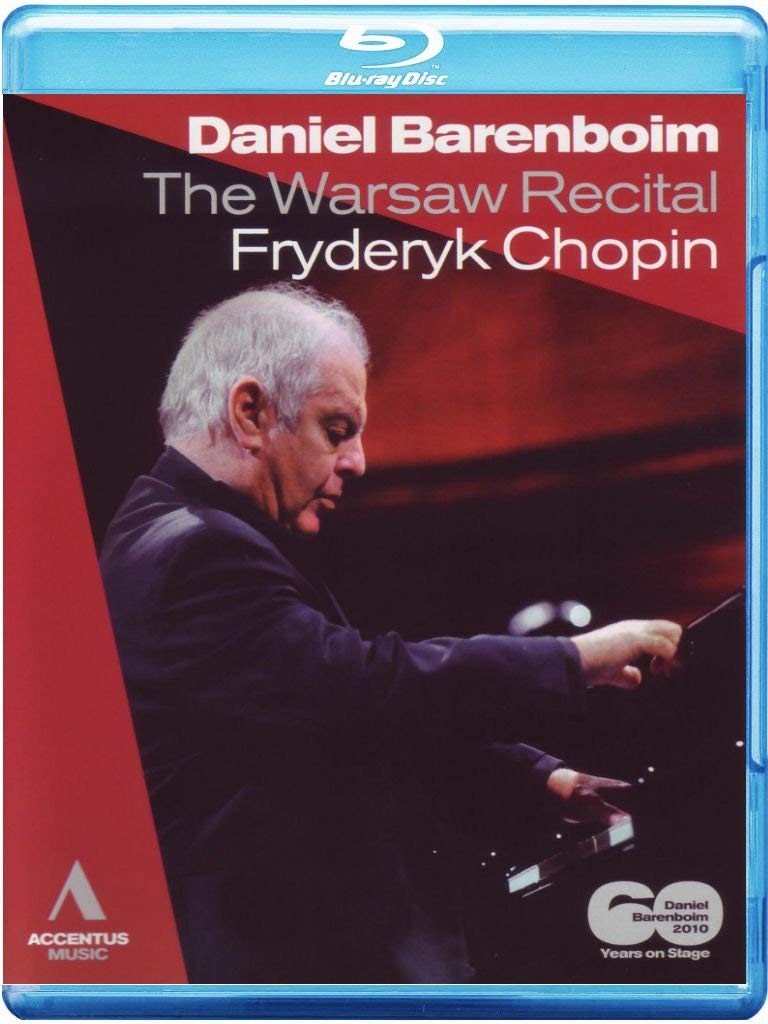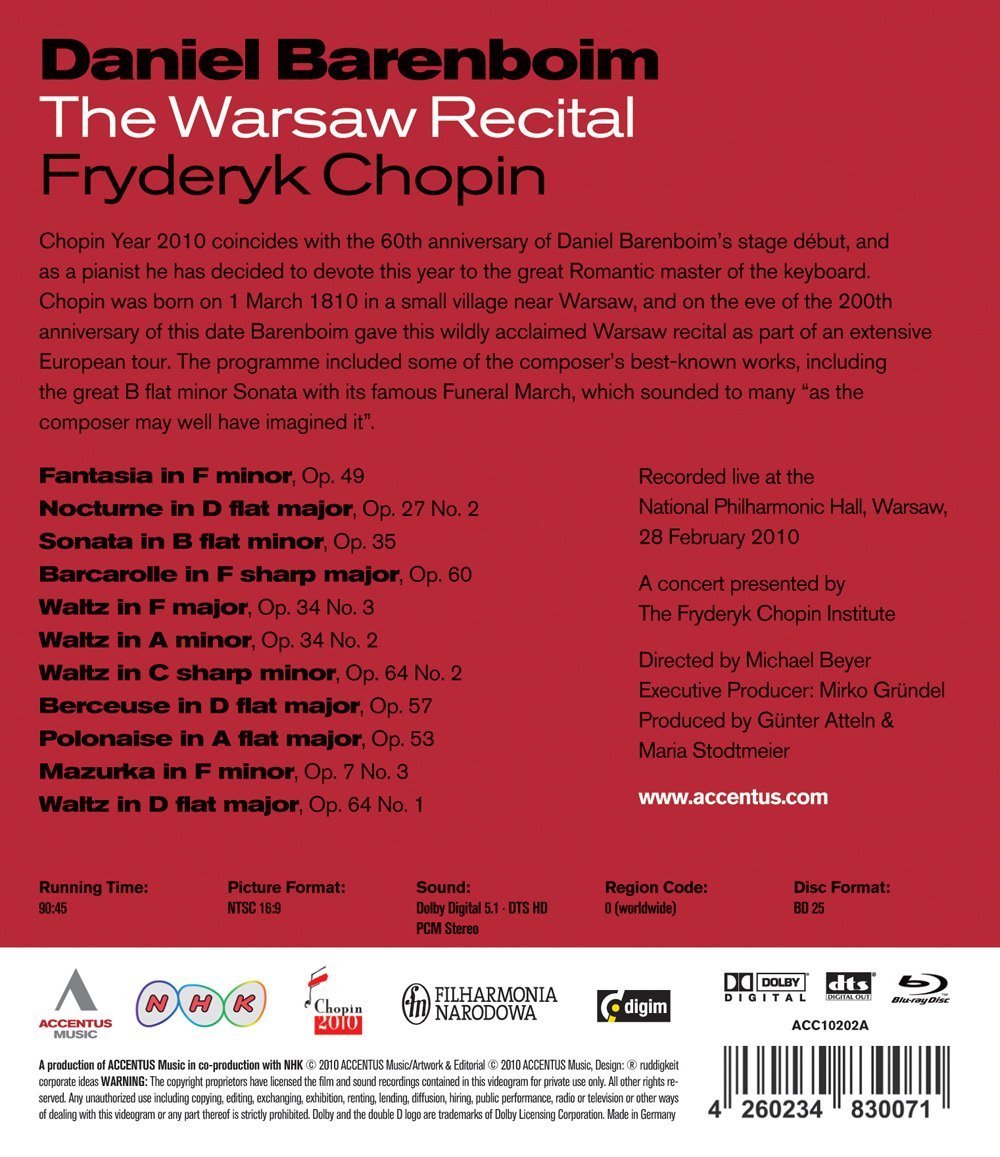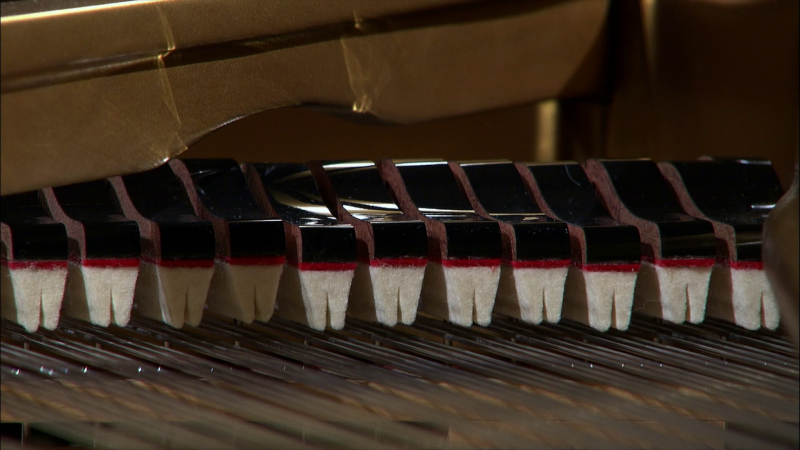

Chopin The Warsaw Recital. Daniel Barenboim performs the following solo Chopin pieces in 2010 at the Warsaw National Philharmonic Hall:
Fantasia in F minor
Nocturne in D flat major
Sonata in B flat minor
Barcarolle in F sharp major
Waltz in F major
Waltz in A minor
Waltz in C sharp minor
Berceuse in D flat major
Polonaise in A flat major
Mazurka in F minor
Waltz in D flat major
Directed for TV by Michael Beyer; Director of Photography was Nyika Jancsó; Audio Producer was Georg Obermayer. Claudia Groh and Günter Atteln were Disc Producers with Executive Producer Paul Smaczny. Released 1011, disc has 5.1 dts-HD Master Audio sound. Grade: A
Daniel Barenboim is probably the most important musician working today (2014). He has had separate fabulous careers as (1) star pianist and (2) esteemed symphony conductor. He has also taken controversial political positions that make him an important figure on the world stage. He campaigned to play Wagner in Israel. He fervently supports Palestinian rights. According to Wikipedia, he was the first Israeli citizen to be granted honorary citizenship by Palestine. But most importantly to us, he has been hyperactive in making HDVD recordings that we cover on this website. Our search tool yields 37 HDVDs for Barenboim. (Netrebko has 25, Kaufmann 24, and Abbado 22.)
Barenboim was 67 when he found time to play 11 Chopin solo pieces in Warsaw at the Polish National Philharmonic Hall. This was a highlight in Poland of The Chopin Year — the 200th anniversary of Chopin's birth. Where could Barenboim find a tougher audience than this?
Here's a picture of the Philharmonic Hall I found on the Internet:
On October 14, 2011, wonk William Huang wrote his review of what we call the Chopin Warsaw Recital. At that time we were not using screenshots in our reviews. Huang is a professional piano player. His report makes it obvious that Barenboim's performance would be competitive (in a field with hundreds of recordings) even if it were only available on a CD. Huang also praises the video recording as best he can without having pictures to show. Well, after you read Huang's review, I'll undergird it with some recent screenshots.
Huang's review:
“In this performance Barenboim summoned all of his physical and intellectual prowess---and charm. Robert Schumann's famous criticism of Chopin's second piano sonata (four unruly children bound together) seems less valid thanks to the precision and sense of architecture Barenboim brings to it. The finale doesn't have the cosmic, manic energy Alfred Cortot brought in a popular EMI account, but Barenboim’s control is remarkable. Until the last note, he plays the whole movement in velvet pianissimo (and with astonishing clarity), showing the finale's journey through the pleasant harmonic changes written in. It makes the final notes that much more of a surprise. Barenboim's wealth of life experience must have brought a warmth and maturity to the Barcarolle, which is uncommon among most competition winners these days. Perhaps the most delightful pieces on this disc are the waltzes---I've never heard Barenboim play with so much grace and finesse.
This concert has a very pleasant and uncommonly no-nonsense camera direction--- I love it. It's not erratic and pretentious like Barenboim's acclaimed 2005 EMI DVD set of the Beethoven Sonatas (which needs to be re-edited and released on blu-ray). In this Chopin video, we always get great shots of his hands or profile which never linger too long or too short. It's just really well thought out compared to the otherwise superb EMI Beethoven cycle. Recorded with modern technology, the handsome Steinway concert grand sounds very real.
A few interpretational quirks in this concert will definitely offend most Chopinists (I didn't particularly admire the repetitive "DING!" sounds Barenboim made in certain notes during the A-minor waltz). His habit of producing thumping sonorities in grand passages (as he does in the Brahms Concertos or Beethoven Sonatas) is present---but are fortunately tolerable. And it's true; there have been other pianists who have brought out more mysticism from the Sonata or drama in the Fantasy. But because Barenboim played all of these works with such convincing authority and the concert was filmed and recorded so well, no connoisseur should forgo experiencing this.
Almost inarguably, this is one of the best classical music Blu-ray discs. This is a milestone in Barenboim's illustrious career and a thoroughly enjoyable product. It fully deserves an "A" grade.”
The first thing our new screenshots give you that a CD can't is information about the venue. The photo above of the Philharmonic Hall shows a practical and traditional exterior free of ostentation. Same for the interior:
Below Barenboim has just entered the stage for the first time. From this angle, the hall looks rather small — almost intimate:
The hall was packed with a well-dressed but also democratic-looking audience. There was standing room for students all along the orchestra seats:
The lighting was low and warm. Here's my favorite image from the whole disc:
HDVD fans believe that seeing the music performed provides valuable information that the ear alone can't relate. The next two images help you appreciate the physical strength and power Barenboim brings to the f to fff passages:
The fff shots make Barenboim's finesse and grace indelicate p to ppp passages all the more impressive. This is obvious in the moving pictures — but can you detect finesse and grace in the next two still images?
And the video sometimes gives you candid views that would never get by the PR folks:
The video can mislead you also. You know a piano keyboard is rectangular. But in the shot below, limitations in the depth of field-of-focus produce an optical illusion: that the keyboard is wider in the treble keys than in the bass keys:
And in the shot below, distortion from a telephoto lens and poor depth of field-of-focus make the keyboard look strange indeed:
Here is an example of good field-of-focus:
The TV director comes up with a clever novelty shot. The Marche fenèbre movement from the Sonata in B flat minor is starting. The white felt damper pads (I think that's the name) move up and down in unison (to stop sympathetic vibration of unplayed strings). You suddenly see the dampers as little soldiers. The soldiers are all slowly marching in a well-kept rank down a wide boulevard as if they were themselves leading the funeral procession. The shot ends before you can consider it a gimmick. (It comes back briefly at the end of the Marche fenèbre.):
Barenboim at the end of the presto Finale movement of the Sonata in B flat minor:
And here at the end of the recital is a big smile of pleasure and relief as the audience of Chopin experts gives Barenboim a standing O:
Finally, the TV director used his cameras to work the audience almost like a politician shaking hands at a party. Even if nobody else wants it, they will sell lots of HDVDs in Warsaw! I think the gent with gray hair next to the beautiful blond lady is Jacek Kaspszyk, Music and Artistic Director of the Warsaw Philharmonic Orchestra:
Who is the gent in the center of this picture? I'm sure I've encountered him before, but my subconscious mind refuses to ID him:
The man with horn rim glasses on the front row (between the two ladies) has to be a local politician or music celeb since the editor left in 2 long shots of him. Can you name him?
I have a hunch these two lovely ladies might be Barenboim relatives. Who are they?
During all those days I spent earlier in life listening to LPs and CDs of classical music, it never occurred to me to wonder what the performers looked like, what they were wearing, what kind of instruments they played, or what the venue and audience looked like. I never dreamed it would ever be possible to know any of this. But now it is. Today I submit that no recording, at least of a live event, is complete without an HD video as well as top-notch sound. But this doesn't mean you have to watch the disc each time you enjoy it. It's not a crime to go about your tasks with the audio only playing in the background. And sometimes while I was reviewing this Barenboim concert, I would close my eyes and just listen.
This is still one of our best classical music HDVDs. The 48kHz/24-bit sound recording was probably state-of-the-art in 2010 and is still considered a best practice today. (We now would prefer 96kHz/24-bit sound, but we rarely get it.) The video, although a bit soft, is very pretty. You would have to be a grinch not to love the program, and this would be safe to show to all your friends and relatives. And even if you are a Chopin connoisseur with a shelf full of 78s, LPs, CDs and DVDs of special Chopin performances you treasure, Huang says you need this recording also. You have the past covered — and this HDVD points the way to the future. We'll stick with the "A" grade.
OR




















